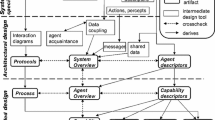Abstract
The proposed scheduling strategy is based on a multi-agent architecture. Each agent of this architecture is dedicated to a work centre (i.e. a set of resources of the manufacturing system); it selects locally and dynamically the most suitable dispatching rules. Depending on local and global considerations, a new selection is carried out each time a predefined event occurs (for example, a machine becomes available, or a machine breaks down). The selection depends on: (1) primary and secondary performance objectives, (2) the operating conditions, and (3) an analysis of the system state, which aims to detect particular symptoms from the values of certain system variables. We explain how the scheduling strategy is shared out between agents, how each agent performs a local dynamic scheduling by selecting an adequate dispatching rule, and how agents can coordinate their actions to perform a global dynamic scheduling of the manufacturing system. Each agent can be implemented through object-oriented formalisms. The selection method is improved through the optimization of the numerical thresholds used in the detection of symptoms. This approach is compared with the use of SPT, SIX, MOD, CEXSPT and CR/SPT on a jobshop problem, already used in other research works. The results indicate significant improvements.
Similar content being viewed by others
References
Attoui, A., Hasbani, A. and Maouche, A. (1995) Specification environment for multi-agent systems based on anonymous communications in the CIM context, in Proceedings of IMSE, European Workshop on Integrated Manufacturing Systems Engineering, 12–14 December, Grenoble, pp. 243–252.
Ayel, J. (1994) Concurrent decisions in production management. Integrated Computer-Aided Engineering Journal, special issue on `AI in manufacturing and robotics'.
Baker, K.R. (1984) Sequencing rules and due-date assignments in a job-shop. Management Science, 30, 1093–1104.
Baker, K.R. and Kanet, J.J. (1983) Job shop scheduling with modified due dates. Journal of Operations Management, 4, 11–22.
Baptiste, P. and Manier, H. (1993) Pilotage d'un anneau flexible de production: une approche définissant un comportement autonome par station, in Proceedings of GSI4: Quatrième Congrès International de Génie Industriel, Marseilles, 15–17 December, pp. 117–126.
Barbuceanu, M. and Fox, M.S. (1994) The information agent: an infrastructure agent supporting collaborative enterprise architectures, in Proceedings of 3rd Workshop on Enabling Technologies: Infrastructure for Collaborative Enterprises, Morgantown, WV, USA, pp. 112–116.
Barrett, R.T. and Barman, S. (1986) A SLAM II simulation study of a simplified flow shop. Simulation, 47, (November), 181-189.
Blackstone, J.H., Phillips, D.T. and Hogg, G.L. (1982) A state-of-the-art survey of dispatching rules for manufacturing job shop operations. International Journal of Production Research, 20, 27–45.
Chandra, J. and Talavage, J. (1991) Intelligent dispatching for flexible manufacturing. International Journal of Production Research, 29, 2259–2278.
Eilon, S. and Cotteril, D.J. (1968) A modified SI rule in job shop sequencing. International Journal of Production Research, 7, 135–145.
Engell, S. and Moser, M. (1992) A survey of priority rules for FMS scheduling and their performance for the benchmark problem, in Proceedings of the 31st IEEE Conference on Decision and Control, Tucson, AZ, December, pp. 392–396.
Ferber, J. (1993) Modèle de systèmes multi-agents–Du réactif au cognitif, in Proceedings of INFAUTOM'93 `du traitement réparti aux systèmes multi-agents et à l'autonomie des systèmes', Toulouse, 18–19 February, pp. 26–56.
Finin, T. et al. (1992) Specification of the KQML Agent Communication Language, DARPA Knowledge Sharing Initiative, External Interfaces Working Group.
Iffnecker, C., Ferber, J. and Zawadzki, D. (1991) Un modèle multi-agents pour l'aide à la coopération de produits électromécaniques, in Proceedings of Onzièmes Journées Internationales les Systèmes Experts et Leurs Applications, Conférence Générale Systèmes Experts de Seconde Génération, Ed. EC2, Vol 2, Avignon, May, pp. 137–151.
Kiran, A.S. and Smith, M.S. (1984) Simulation studies in job shop scheduling: a survey. Computers and Industrial Engineering, 8, 46–51.
Kwok, A. and Norrie, D. (1993) Intelligent agent systems for manufacturing applications. Journal of Intelligent Manufacturing, 4, 285–293.
Law, A.M. and Kelton, W.D. (1982) Simulation Modelling and Analysis, 2nd edn, McGraw-Hill, Singapore.
Lefrançois, P. and Montreuil, B. (1994) An object-oriented knowledge representation for intelligent control of manufacturing workstation. IIE Transactions, Industrial Engineering Research and Development, 26,(1), 11–26.
Mebarki, N. (1995) Une approche d'ordonnancement temps réel basée sur la sélection dynamique de règles de priorité, Doctoral dissertation, Université Claude Bernard lyon I, Lyon, France.
Montazeri, M. and Van Wassenhove, L.N. (1990) Analysis of scheduling rules for an FMS. International Journal of Production Research, 28, 785–802.
Ouzrout, Y. (1996) Modélisation et simulation d'organisation productive réactives: une approche multi-agents, PhD dissertation, INSA de Lyon, 96 ISAL 0032, Lyon, France.
Parunak, H.V.D. (1993) Industrial applications of multi-agent systems, in Proceedings of INFAUTOM'93: Du Traitement Réparti aux Systèmes Multi-Agents et à l'Autonomie des Systèmes', 18–19 February, Toulouse, Session B3 P. 16.
Pierreval, H. (1992) Expert system for selecting priority rules in flexible manufacturing systems. Expert Systems with Applications, 5, 51–57.
Pierreval, H. and Mebarki, N. (1997) Dynamic selection of dispatching rules for manufacturing systems. International Journal of Production Research, in press.
Russel, R., Dar-EL, E.M. and Taylor, B.W. (1987) A comparative analysis of the COVERT job sequencing rule using various shop performance measures. International Journal of Production Research, 25, 1523–1540.
Schultz, C.R. (1989) An expediting heuristic for the shortest processing time dispatching rule. International Journal of Production Research, 1, 31–41.
Tacquard, C., Baptiste, P. and Manier, H. (1994) Model of a behavior approach to schedule and control a flexible manufacturing ring: an extension to the pull flow, in Proceedings of IMSE, European Workshop on Integrated Manufacturing Systems Engineering, 12–14 December, Grenoble, pp. 333–339.
Trentesaux, D. and Tahon, C. (1995) Dynamic and distributed production activity control: a multicriteria approach for task allocation problematic, in Proceedings of IEPM'95 International Conference on Industrial Engineering and Production Management, Marrakech, April, pp. 137–155.
Trouilhet, S. (1993) Présentation et traitement des connaissances sociales chez l'agent: Application à l'environnement multiagents SYSNERGIC, Doctoral dissertation, Université Paul Sabatier, Toulouse, France.
Author information
Authors and Affiliations
Rights and permissions
About this article
Cite this article
KOUISS , K., PIERREVAL , H. & MEBARKI , N. Using multi-agent architecture in FMS for dynamic scheduling. Journal of Intelligent Manufacturing 8, 41–47 (1997). https://doi.org/10.1023/A:1018540317470
Issue Date:
DOI: https://doi.org/10.1023/A:1018540317470




